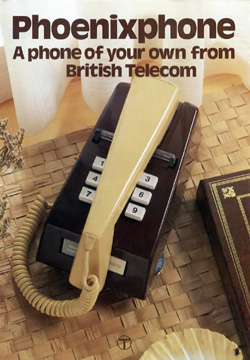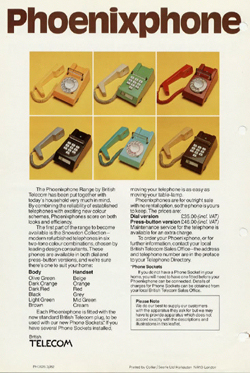 |
Phoenixphones were simply 700 type phones and Trimphones refurbished in an 'exciting range of colours.' This was an early attempt to capture the new 'decorator market', for stylish designs, at the start of the UK liberalization which had begun with the introduction of the 'new phone socket' system of plug-in phones in 1981. |
Historically, BT's huge rental base of 700 type telephones, switchboards, bells, buzzers & hooters etc., was already supported by the Post Office Factory Division or FacD. Telephones and other rental items recovered from the field were effectively re-manufactured and returned to Stores Depots for re-issue. This process was possible because most apparatus contained many 'piece parts' which were suitable for repair/replacement. For example, a new circuit board could be fitted to an otherwise defunct telephone. Full refurbishment included polishing the case, so that the re-manufactured product was finished to a 'better than new' standard! Thus Phoenixphones were produced by BT's factory at Cwmcarn and launched nationally in February 1982.
P h o e n i x p h o n e Tariffs
A phone of your own from British Telecom Four phases of the Phoenixphone Campaign were planned, each to release 100,000 plug-ended telephones onto the market on outright sale only.
Tariffs (outright sale)
| Dial Trimphone | £35:00 inc VAT |
| PB 700 Type | £40:00 inc VAT |
| PB Trimphone | £46:00 inc VAT |
In 1982 VAT was 15%.
The Snowdon Collection
Phase 1 of the Phoenixphone campaign was marketed as 'The Snowdon Collection' comprising, 60,000 repaired dial Trimphones and 40,000 new keypad Trimphones from stock.
| Marketing/ Engineering Title | Item Code Number | Advice Note & AX8000 Description | |
| Phoenixphone Range Tele 8722G |
410708 410709 410710 410711 410712 410713 |
Dial Snowdon Phoenixphone Dial Snowdon Phoenixphone Dial Snowdon Phoenixphone Dial Snowdon Phoenixphone Dial Snowdon Phoenixphone Dial Snowdon Phoenixphone |
Olive G/Beige T/T Orange Brn/Cream T/T Red Blk/Grey T/T Green |
| Phoenixphone Range Tele 8766 |
410714 410715 410716 410717 410718 410719 |
PB Snowdon Phoenixphone PB Snowdon Phoenixphone PB Snowdon Phoenixphone PB Snowdon Phoenixphone PB Snowdon Phoenixphone PB Snowdon Phoenixphone |
Olive G/Beige T/T Orange Brn/Cream T/T Red Blk/Grey TT/T Green |
Trimphone type Phoenixphones were converted to High Impedance ringers by the addition of a 3.3k ohm resistor in series with the tone ringer unit.
Note: Tables from THQ Circular S1 B8217 March '82
Phoenixphone Leaflet
| Body | Handset |
The first part of the range to become available is the Snowdon Collection- modern refurbished telephones in six two-tone colour combinations, chosen by leading design consultants. These phones are available in both dial and press-button versions, and we're sure there's one to suit your home. |
| Olive Green | Beige | |
| Dark Orange | Orange | |
| Dark Red | Red | |
| Black | Grey | |
| Light Green | Mid Green | |
| Brown | Cream |
Maintenance service for the telephone is available for an extra charge. To order your Phoenixphone, or for further information, contact your local British Telecom Sales Office-the address and telephone number are in the preface to your Telephone Directory.
*Phone Sockets If you do not have a Phone Socket in your home, you will need to have one fitted before your Phoenixphone can be connected. Details of charges for Phone Sockets can be obtained from your local British Telecom Sales Office.
Later Phases
Phase 2 was to use old stocks of 700 type telephones converted to keypad versions.
Phase 3 was to convert old stocks of dial Trimphones to keypad versions using a FacD developed keypad.
Phase 4 was to convert stocks of dial 700 series to keypad versions again using a FacD keypad.
Phases 3 & 4 were to use new case designs. It is not known if the later phases actually went ahead. It is likely that new phones on the market displaced the appeal of the Phoenixphones.
FacD was the Post Office's Factory Division which continued into the early years of British Telecom.
Page last updated 20th November 2011. Checked June 2021.
All logos and trade marks are the property of their respective owners and are used on the Light Straw site(s) for review only. Students and researchers are recommended to make their own independent enquiries as to the accuracy of the information contained therein.
